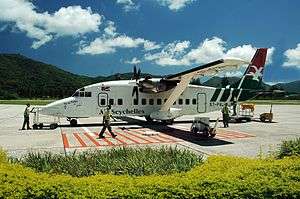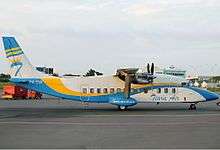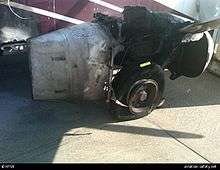Short 360
| Short 360 | |
|---|---|
 | |
| An Air Seychelles Short 360 | |
| Role | Transport aircraft |
| National origin | United Kingdom |
| Manufacturer | Short Brothers |
| First flight | 1 June 1981 |
| Introduction | November 1982 |
| Primary users | Air Cargo Carriers Emerald Airways Aeroperlas Skyway Enterprises |
| Produced | 1981–1991 |
| Number built | 165 |
| Developed from | Short 330 |
| Variants | Short C-23B/C Sherpa |
The Short 360 (also SD3-60; also Shorts 360)[1] is a commuter aircraft that was built by British manufacturer Short Brothers during the 1980s. The Short 360 seats up to 39 passengers and was introduced into service in November 1982. It is a larger version of the Short 330. It is also affectionately known in aviation circles as "The Shed".
Development
During the 1970s the world's commuter airline market began to evolve from the 20-seat class to larger and more comfortable cabins. Short Brothers of Northern Ireland had created the Skyvan in 1962, followed by the related but larger Short 330 in 1974.

The Short 360 is a 36-seat derivative of the 30–33 seat Short 330. In high density configuration, 39 passengers could be carried. The two Short airliners have a high degree of commonality and are very close in overall dimensions. The later 360 is easily identified by a larger, swept tail unit mounted on a revised rear fuselage. The 360 has a 3'0" (91 cm) fuselage "plug" which gave sufficient additional length for two more seat rows (six more passengers), while the extra length smoothed out the aerodynamic profile and reduced drag.[1] Seating is arranged with two seats on the starboard side of the cabin and one seat on the port side. The 360's power is supplied by two Pratt & Whitney PT6A-65Rs. The development was announced in 1980, with the prototype's first flight on 1 June 1981[2] and type certification awarded on 3 September 1981.
After initiating production with the basic model, Short marketed a number of 360 developments. First was the 360 Advanced, in late 1985, with 1,424 shp (1,062 kW) PT6A-65-AR engines. That was followed by the 360/300, in March 1987, with six-blade propellers, more powerful PT6A-67R engines, and aerodynamic improvements, giving a higher cruise speed and improved "hot and high" performance. The 360/300 was also built in 360/300F freighter configuration.
Operational history
![A Short Brothers 360 sits at Rocky Mountain Metropolitan Airport [KBJC]](../I/m/Short_Brothers_360_(SD3-60).jpg)
The first production Short 360 had its maiden flight on 19 August 1982[3] and entered service with Suburban Airlines (later merged with Allegheny Airlines/US Airways) in November 1982.[4] Building on the strengths and reputation of its 330 antecedent, the 360s found a niche in regional airline use worldwide, being able to operate comfortably from 4,500 ft (1,400 m) runways – opening up hundreds of airfields that would otherwise be inaccessible to airliners. With a cruise speed about 215 mph (370 km/h), at an altitude of 10,000 ft (3,048 m), the unpressurized 360 was not the fastest turboprop in its market but it offered acceptable performance at a reasonable price combined with ease of service and maintainability.[5] The PT6A turboprops are fully ICAO Stage 3 noise-compliant, making the 360 one of the quietest turboprop aircraft operating today. Production of the 360 ceased in 1991 after 165 deliveries.[6] In 1998, approximately 110 360s were in service.[6] In 2009 a retired Emerald Airlines 360 was bought by Kingsland Primary School in Stoke-on-Trent, for use as a mobile classroom.[7]
Variants
.jpg)
- 360-100 - the first production model with Pratt & Whitney Canada PT6A-65R turboprop engines.[8]
- 360 Advanced - with PT6A-65AR engines rated at 1,424 shp (1,062 kW) each.[8] The aircraft was later redesignated 360-200. Introduced in late 1985.[8]
- 360-300 - with more powerful PT6A-67R engines with six-blade propellers. Higher cruise speed and improved performance.[8]
- 360-300F - the freighter version of the -300,[8] with capacity for five LD3 cargo containers.
- Short C-23 Sherpa B+ and C variants are military-configured Short 360s operated by the United States military.[9] Twenty-eight C-23B+ were produced by conversions of civilian Short 360 airframes, and the C-23C was a conversion of C-23B and C-23B+.
Operators

%2C_Dublin%2C_June_1995_(01).jpg)
In 2013 there were a total of 13 Short 360 aircraft (all variants) in passenger service with Air Seychelles (1), Deraya Air Taxi (2), Pacific Coastal Airlines (2, stored out of service), Servicios Aéreos Profesionales (1), Tiara Air (2), Interisland Airways (1), La Costena (1), Comeravia (1), Malu Aviation (1) and Ayit Aviation and Tourism (1).[10] The Short 360 specifically proved very popular with the U.K.'s regional airlines including the Isle of Man-based-Manx. This fed passengers into larger hubs in England, Scotland and Ireland.
Current and previous operators have included:
Civil operators
- Hazelton Airlines
- Murray Valley Airlines
- Sunshine Express Airlines
- Sunstate Airlines (QantasLink)
- Airlines of Tasmania
- TACA (SANSA)
- Malu Aviation
- SAP Air Group
- Nightexpress
- Rheinland Air Service (RAS)
- Express Airways (EPA)
- TACA (INTER)
- Air Seychelles (Former)
- HD Air (formerly BAC Express)[16]
- British Regional Airways/Loganair[17]
- Manx Airlines
- Jersey European (now Flybe)[18]
- Gill Airways[19]
- Allegheny Commuter Airlines (operated by Pennsylvania Airlines and Suburban Airlines)
- American Eagle (operated by Executive Airlines, Flagship Airlines and Simmons Airlines)
- Air Cargo Carriers
- Business Express
- Comair
- Dash Air
- Federal Express[20]
- Gulfstream International Airlines
- Imperial Airlines
- Interisland Airways (Hawaii)
- Mississippi Valley Airlines (MVA)
- Trans Executive Airlines
- Trans International Express
- United Express (operated by WestAir Commuter Airlines)
- US Airways Express (operated by Allegheny Commuter Airlines)
- US Forest Service (smokejumper aircraft)
A number of small air cargo airlines have also operated the Short 360 in freight operations in the U.S.
Military operators
- Venezuelan Air Force (Fuerza Aérea Venezolana)
Accidents and incidents
The Short 360 has been involved in 15 hull-loss accidents, resulting in the loss of 16 airframes.[21]
- 22 October 1985: A CAAC flight overran the runway while landing at Enshi Airport. There were no fatalities, but the airframe was written off.
- 31 January 1986: An Aer Lingus flight crashed on approach to East Midlands Airport, UK, due to airframe icing and turbulent conditions. There were no fatalities, but the airframe was written off.
- 13 December 1987: Philippine Airlines Flight 443, using a Short 360 registration EI-BTJ crashed into a 5,000' mountain in the Philippines while approaching Iligan. All 11 passengers and 4 crew on board were killed.
- 28 November 1989: A newly built aircraft, not yet delivered to a customer, was destroyed by a bomb on the apron at Belfast City Airport, Northern Ireland. The device had been planted by the IRA. There were no fatalities.,
- 20 August 1990: A CCAir aircraft parked at Charlotte-Douglas Airport (Charlotte, North Carolina, USA) was blown by a wind gust into an electrical power cart, and a fire started. There were no fatalities, but the airframe was written off.
- 25 November 1997: An aircraft operated by Corporate Air landed heavily at Billings-Logan Airport (Billings, Montana, USA) in gusty wind conditions. The nosewheel strut collapsed, leading to a crash with the loss of the airframe. There were no fatalities.
- 9 February 1998: A British Regional Airlines aircraft landed heavily at Stornoway Airport In Scotland. The undercarriage was damaged leading to a crash with the loss of the airframe. There were no fatalities.

- 13 January 2000: A Sirte Oil Company Short 360 crashed on approach near Brega; 22 of the 41 passengers and crew on board were killed.
- 23 September 2000: A Gill Airways flight was forced to make an emergency landing after it's left engine failed[22]. There were no injuries.
- 4 February 2001: Short 360-100 registration EI-BPD, carrying 25 passengers and 3 crew,[23] was damaged beyond repair following a hard landing at Sheffield City Airport after a scheduled Aer Arann Express passenger flight from Dublin.[24] There were no injuries.
- 27 February 2001: Loganair Flight 670 crashed into the Firth of Forth in Scotland shortly after takeoff from Edinburgh Airport. Both engines failed after ingesting blowing snow while on the ground. Both pilots were killed (no others on board).
- 21 August 2004: A Venezuelan Air Force Short 360 crashed into a mountain while descending to land at Maracay, killing all 30 people on board.
- 16 December 2004: An Air Cargo Carriers aircraft was lost at Oshawa Municipal Airport. After landing on a snow-covered runway, the pilot attempted a go-around when he realized he would be unable to stop. The aircraft failed to gain altitude and crashed. There were no fatalities.
- 5 February 2006: Two Short 360-300 freighters, modded for a DOD contract, operated by Air Cargo Carriers, were flying in formation when they collided near Watertown, Wisconsin, US. N3735W attempted to maneuver below N372AC in a right turn and struck the left/ underside of N372AC. The left wing outer section of N3735W was struck and separated by the leading edge of N372AC's left wing, and the aircraft crashed, killing all three occupants. The left propeller of N3735W had struck the forward section of the left "stub wing" of N372AC (the structure housing the left main landing gear and hydraulic service panel). N372AC sustained severe damage, including structural, engine, propeller (losing several blades), aerodynamic, and complete hydraulic failure (affecting flaps, landing gear, nose wheel steering, and primary brakes). The crew managed to make an emergency landing at Dodge County Airport in Juneau, WI (KUNU), but overran the runway due to the damage to the aircraft. The left aileron of N3735W was found on the runway that N372AC landed on. Both crewmen survived uninjured, but N372AC was damaged beyond reasonable repair.
- 17 May 2012: An Air Cargo Carriers Short 360 (registration N617FB) was substantially damaged following a wheel brake fire during taxi at the George Bush Intercontinental Airport, Houston, Texas. There were no injuries to the flight crew of two. The airplane was 60 pounds over Max. takeoff weight and during the long taxi to position for takeoff the crew used a higher than normal power setting and rode the brakes in an attempt lower weight by burning fuel. It's intended destination was Austin, Texas.
- 29 October 2014: A Skyway Enterprises Short SD-360 (registration N380MQ) cargo flight on behalf of FedEx, scheduled from Sint Maarten, Kingdom of Netherlands to San Juan, Puerto Rico lost altitude during climb out and crashed into the water about 2 nautical miles off the end of runway at about 18:35L (22:35 UTC), killing both members of the flight crew.
Specifications (360-300)
Data from Flight International[25]
General characteristics
- Crew: Three (Two pilots plus one cabin crew)
- Capacity: 36 passengers
- Length: 70.8 ft (21.58 m)
- Wingspan: 74.8 ft (22.81 m)
- Height: 23.67 ft (7.21 m)
- Wing area: 454 ft² (42.09 m²)
- Airfoil: NACA 63A series (modified)[26]
- Empty weight: 17,350 lb[26] (7,870 kg)
- Max. takeoff weight: 27,100 lb (12,292 kg)
- fuel capacity: 480 Gal (2,182 l)
- Powerplant: 2 × Pratt & Whitney Canada PT6A-65AR turboprop, 1,424 shp (1,062 kW) each
Performance
- Maximum speed: 218 kts (404 km/h, 251 mph) Max cruise at FL 100
- Cruise speed: 180 kts (333 km/h, 207 mph) Long range cruise at FL100
- Stall speed: 85 mph (73 kn, 136 km/h) (flaps and landing gear down)[26]
- Range: 861 nmi (1,596 km) full tanks, 5,663 lb (2,569 kg) payload
- Service ceiling: 20,000 ft MSL [27] (6,096 m MSL)
- Rate of climb: 952 ft/min[26] (4.7 m/s)
- Fuel consumption: Max cruise: 992 lb/hr (450 kg/hr), long range cruise: 762 lb/hr (346 kg/hr)
See also
Related development
Related lists
References
Notes
- 1 2 Mondey 1981, p. 228.
- ↑ Simpson 2001, p. 495
- ↑ "embraer - fairchild - 1982 - 2182 - Flight Archive".
- ↑ Eastwood/Roach p. 455.
- ↑ Smith 1986, p. 2.
- 1 2 "Short 360." Airliners.net. Retrieved: 9 August 2007.
- ↑ Narain, Jayra. "Fasten your seat belts, children, your new geography classroom has landed in the playground." Daily Mail, 31 March 2009. Retrieved: 18 May 2011.
- 1 2 3 4 5 Frawley 2003, p. 193.
- ↑ "Olive-Drab: C-23." olive-drab.com. Retrieved: 18 August 2010.
- ↑ Last Chance to Fly, 2012.
- ↑ "Freedom Air." Archived 7 August 2008 at the Wayback Machine. freedomairguam.com. Retrieved: 18 August 2010.
- ↑ "HR-IAP." biglobe.ne.jp. Retrieved: 18 August 2010.
- ↑ "EI-BSP." airliners.net. Retrieved: 18 August 2010.
- ↑ "La Costeña." airliners.net.
- ↑ "HS-TSE." biglobe.ne.jp. Retrieved: 18 August 2010.
- ↑ "Fleet: G-CLAS," "G-EXPS," "G-TMRA" and "G-TMRB." Archived 31 March 2009 at the Wayback Machine. hdair.com. Retrieved: 18 August 2010.
- ↑ "G-BNMT." Archived 3 March 2005 at the Wayback Machine. users.zetnet.co.uk. Retrieved: 18 August 2010.
- ↑ G-OBHD Retrieved: 18 August 2010.
- ↑ "G-BNYI." Archived 2 November 2005 at the Wayback Machine. users.zetnet.co.uk. Retrieved: 18 August 2010.
- ↑ "About FedEx: FedEx Facts." Archived 7 August 2007 at the Wayback Machine. FedEx. REtrieved: 18 May 2011.
- ↑ "Short 360: hull losses." aviation-safety.net. Retrieved; 24 April 2013.
- ↑ "Engine failure hits flight". HeraldScotland. Retrieved 2018-08-02.
- ↑ https://reports.aviation-safety.net/2001/20010204-0_SH36_EI-BPD.pdf
- ↑ https://aviation-safety.net/database/record.php?id=20010204-0
- ↑ "Commuter Aircraft Directory". Flight International. 7 May 1988.
- 1 2 3 4 Jane's All The World's Aircraft 1988–89, pp. 305–307.
- ↑ "TCDS A41EU" (PDF). FAA. March 21, 2007.
Bibliography
- Barnes C.H. and Derek N. James.Shorts Aircraft since 1900. London: Putnam, 1989. ISBN 0-85177-819-4.
- Donald, David, ed. The Encyclopedia of Civil Aircraft. London: Aurum, 1999. ISBN 1-85410-642-2.
- Eastwood Tony and Roach John.Turbo Prop Airliner Production List. West Drayton: The Aviation Hobby Shop, 2007.
- Frawley, Gerard. The International Directory of Civil Aircraft, 2003/2004. Fyshwick, ACT, Australia: Aerospace Publications Pty Ltd., 2003. ISBN 1-875671-58-7.
- Mondey, David. Encyclopedia of the World's Commercial and Private Aircraft. New York: Crescent Books, 1981. ISBN 0-517-36285-6.
- Simpson, Rod. Airlife's World Aircraft. London: Airlife Publishing Ltd., 2001. ISBN 1-84037-115-3.
- Taylor, John W. R. Jane's All The World's Aircraft 1988–89. Coulsdon, UK: Jane's Defence Data, 1988. ISBN 0-7106-0867-5.
- Smith, P.R. Shorts 330 and 360 (Air Portfolios 2). London: Jane's Publishing Company Limited, 1986. ISBN 0-7106-0425-4.
External links
| Wikimedia Commons has media related to Short 360. |